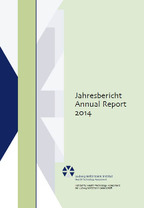Announcements

Current & archive
Vaccination against human papillomavirus (HPV). Decision-aid for young women and girls
In 2008 the German AOK-Bundesverband commissioned the LBI-HTA to develop a decision-aid on the vaccination against Human Papillomavirus (HPV) for young women and girls (online since June 2009). After smaller updates in 2010 and 2011, the updated, completely revised and partly new structured decision-aid went online in March 2015 (www.hpv-entscheidungshilfe.de).The first part of the decision aid contains information about the virus and HPV related diseases. The second part of the decision aid informs about the HPV-vaccine(s). Finally, the third part of the decision aid summarises information of parts I and II: eleven short information blocks can be rated according to the relevance for the decision (mainly pro or mainly contra vaccination or of no influence). In the present project report online contents are available in paper form for the first time. Hence, we were able to add country specific data for Austria and provide further, more detailed information (which has not been included in the online version due to complexity).
Publication: Decision Support Document No. 79: https://eprints.aihta.at/1050
Contact: Brigitte Piso
Horizon Scanning in Onkology - Reports
We are pleased to introduce our new HSO report.
DSD HSO No. 50
Nivolumab (Opdivo®) as single-agent first-line therapy for unresectable or metastatic melanoma
Hadron therapy in children: evidence synthesis for 15 paediatric tumours. Report based on Belgian (KCE) HTA report
A Belgian KCE-Assessment analysed – as an update of the 2007 report – the evidence for hadron therapy (proton and carbon ions) in 15 paediatric indications. Since 2015 the Austrian MedAustron started operating and the first patients are treated, the LBI -HTA has been involved in the Belgian report as external expert. Now the LBI -HTA wrote – due to the regional relevance – a German summary of the Belgian report.
In the assessment 21 clinical studies (non-randomized, non-controlled and mostly retrospective) were found. All studies showed serious methodological flaws. The conclusion therefore is that to date clinical data on PBT in all paediatric cancers under study are lacking as well as critical information on long-term effectiveness and harms.
Prospective comparative clinical trials in the field are urgently needed.
Publication: Decision Support Document Nr. 88: https://eprints.aihta.at/1049
Contact: Claudia Wild
Vasoprotectives: Efficacy and safety of capillary stabilising agents for venous insufficiency or haemorrhoidal diseases
The systematic review assessed the efficacy and safety of a treatment of chronic venous insufficiency (CVI) and haemorrhoidal diseases (HD) with capillary stabilising agents that are listed in the Austrian Code of Reimbursement.
A total of 56 studies were included for a data synthesis.
The majority of studies have shown that the symptoms and signs of CVI and HD can be reduced slightly with the agents (mostly when compared to placebo). Only minor side effects occurred.
However, the strength of the evidence of nearly all identified studies is low. Therefore, we cannot draw a final conclusion on the efficacy of capillary stabilising agents for the treatment of CVI and HD.
Publication: LBI-HTA Project report No. 79: https://eprints.aihta.at/1047
Contact: Stefan Fischer
PET/PET-CT Evidence for need based planning (in oncology indications)
In nearly all Western countries, HTA-reports on Positron Emission Tomography/PET imaging have been written in the last two decades. 155 only in the last 10 years (!) Hardly any other medical technology has undergone so many evaluations. This large abundance is ultimately an expression of an unfading uncertainty about the value of PET imaging in patient care. The (Austrian) HTA report has the intention of supplying decision support for evidence- and needs-based PET device planning. Results from 35 HTAs and recommendations from 7 medical societies have been taken into consideration in the HTA report.
Publication: LBI-HTA Project report No. 77: https://eprints.aihta.at/1045
Contact: Claudia Wild
Horizon Scanning in Onkology - Reports
We are pleased to introduce our new HSO report.
DSD HSO No. 49
Idelalisib (Zydelig®) in addition to rituximab for the treatment of relapsed chronic lymphocytic leukaemia
Acupuncture - areas of application, current evidence and proven indications
This report provides an overview of possible applications and the current evidence on the effectiveness of acupuncture. Recommendations of the WHO and professional associations as well as the results of an overview of Cochrane Reviews are compared with 25 approved indications from the Austrian Health Council (Oberster Sanitätsrat, OSR), an advisory committee for the Ministry of Health and enables to identify indications for which (in)effectiveness is proven.
Publication: LBI-HTA Project report No. 78: https://eprints.aihta.at/1042
Contact: Brigitte Piso
Opportunities and strategies to drive appropriate use of MRI in Austria
Magnetic resonance imaging (MRI) is an essential component of medical care. Currently, however, the appropriateness of diagnostic imaging is increasingly debated. With more than 100 MRI exams yearly per 1,000 population, Austria is leading in MRI utilisation in comparison to other OECD countries. In database screening, literature review and interviews with stakeholders we aimed to identify recommendations against the use of MRI and opportunities and strategies to drive appropriate imaging relevant to the Austrian context.
Publication: Decision Support Document No. 80: https://eprints.aihta.at/1043
Contact: Agnes Kisser
Procedural guidance for the systematic evaluation of biomarker tests
The usefulness of a biomarker test requires the demonstration of its diagnostic accuracy together with the demonstration of its clinical utility. The methodology for evidence-based evaluation of biomarkers is not yet fully established. In this project we reviewed current methodological approaches and synthesised them into a procedural guidance.
Publication: Decision Support Document No. 77: https://eprints.aihta.at/1041
Contact: Agnes Kisser



























